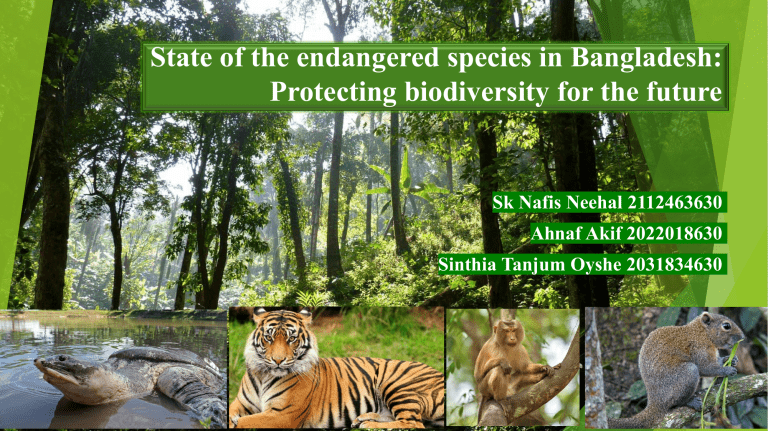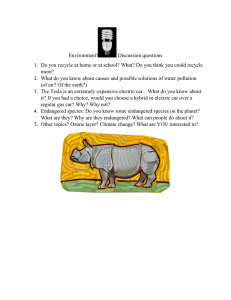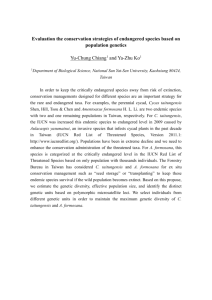
State of the endangered species in Bangladesh: Protecting biodiversity for the future Sk Nafis Neehal 2112463630 Ahnaf Akif 2022018630 Sinthia Tanjum Oyshe 2031834630 Threatened & Endangered species Definition of endangered species: Species that are so rare that they are already in danger of becoming extinct. These species are very few in numbers and will become extinct Definition of threatened species: Species that are likely to become endangered species in the near future. These species are on the verge of becoming extinct if we do not take steps to protect them. IUCN Red listed species: EX EW CR EN VU NT LC DD NE (Extinct) (Extinct in the wild) (Critically endangered ) (Endangered) (Vulnerable) (Near threatened ) (Least concern) (Data deficient) (Not evaluated) Asian twohorned rhinoceros Black Softshell Turtle Asian Elephant Assamese Macaque Rhesus Macaque Giant Flying Squirrel Sind Rice Rat Brushtailed Porcupine White toothed Pigmy Shrew Spectacles langur Pig-tailed Macaque Bengal Fox Common Tree Shrew Orangebellied Himalayan Squirrel Short-tailed Thick-eared Bandicoot Bats Rat swamp deer Table: IUCN Red listed Species in Bangladesh Spatial & temporal distribution of threatened & endangered species: Asian two-horned rhinoceros: Swamp deer: The foothills of the Eastern Himalayas in Bhutan and eastern India. Lives in the Indian subcontinent's swampy grasslands and floodplains. Comilla and the Chittagong Hill Tracts are the two areas in Bangladesh. In Bangladesh it can be found in Sundarbans. It is rare Since 1950s. Fig: Sumatran rhino Fig: Sumatran rhino’s distribution Fig: Swam deer Black Softshell Turtle: freshwater turtle found in India (Assam) and Bangladesh (Chittagong and Sylhet). Asian Elephant: Hilly and non-hilly evergreen forests of Chittagong, Chittagong Hill Tracts (Bandarban, Khagrachari and Rangamati), Cox's Bazar regions. The number of wild elephants was projected to be 195-234 in the early 1990s, with 83-100 of them being trans-boundary elephants. Fig: Black softshell turtle Assamese Macaque: Nepal to central Bhutan and the Sundarbans in Bangladesh, passing through Uttar Pradesh, Sikkim, Assam, and northernmost West Bengal in northern India. Fig: Asian Elephant’s distribution Fig: Assamese Macaque Fig: Asian Elephant Spectacled langur: Rhesus Macaque: Chittagong Hill Tracts (CHT) forest . In 1982,a joint research that there were 1,300 of these species at the time Fig: Spectacled langur It is the only primate species native to the Sundarbans. They are the most commensal of the non-human primates in many Asian countries such as Afghanistan, Pakistan, India, Myanmar, Nepal, China and Vietnam. Fig: Rhesus Macaque Bengal Fox: Himalayan foothills and the Terai region of Nepal, in southern India and eastern and southern Pakistan, as well as in India's east and southeastern Bangladesh mostly the hilly tropical forests of northern hilly Chittagong. Fig: Bengal Fox Northern Tree Shrew: Brush-tailed Porcupine: It is native to Bangladesh, China, India, Lao PDR, Malaysia, Myanmar, Thailand and Viet Nam. Occurs mainly in the mixed evergreen forests of the Chittagong Hill Tracts, but might also occur in the mixed evergreen forests of Greater Sylhet. This species has a very extensive natural range in south-eastern Asia, extending from India and southwestern China to Malaysia, Borneo, and the Philippines. Fig: Northern Tree Shrew white-toothed shrew: It is found in Bangladesh, China, India, Indonesia, Malaysia, Myanmar. BARI-UNDP team found them in hilly areas of Chittagong during 2007-2008. Fig: Asian lesser white-toothed shrew Fig: Brush-tailed Porcupine Causes of such extinction: Habitat destruction. Invasive Species. Over-exploitation of Species. Global Warming and Climate Change. Pollution. Human Overpopulation. Natural Calamities. Genetic Pollution. Invasive alien species. Legal approaches to protect endangered species: Find out about threatened and endangered species in your state. Build a wildlife sanctuary in your backyard. Using pesticides and herbicides sparingly. Conserve water in your home and garden. Stick decals on windows to keep birds away. Drive slowly to avoid accident with other animals. Recycle and purchase goods that are environmentally friendly. Don't litter or otherwise damage fragile habitats that may be home to native/visiting species. Lead or engage in a “clean up” campaign of a significant ecosystem in your region. Never buy endangered species items like ivory, coral, or tortoise shell. Go to a national wildlife refuge, a park, or any other open area. Participate in the annual Stop Extinction Challenge with others (and organize). Reference “IUCN redlist”, Available at (https://en.wikipedia.org/wiki/IUCN_Red_List) and (https://portals.iucn.org/library/sites/library/files/documents/RL-549.3-003-v.1.pdf) Spatial and temporal distribution “IUCN Redlist Bangladesh 2015”(https://portals.iucn.org/library/sites/library/files/documents/RL-549.3-003-v.1.pdf) Endangered species distribution “IUCN redlist” available at (https://www.iucn.org/content/red-list-bangladeshvolume-2-mammals) Threatened species “IUCN redlist” available at (https://www.iucn.org/content/red-list-bangladesh-volume-4reptiles-and-amphibians) Causes of extinction “Loss of Biodiversity” available at (https://en.wikipedia.org/wiki/Biodiversity) Author’s Contribution SK Nafis Neehal(slide2,3): Definition of threatened and endangered species, IUCN red listed species, review, visualization. Ahnaf Akif(slide4-7): Spatial and temporal distribution, formal analysis, slide making, editing. Sinthia Tanjum Oyshe(slide8-10): Causes of extinction, Legal Approaches, review. THANK YOU




